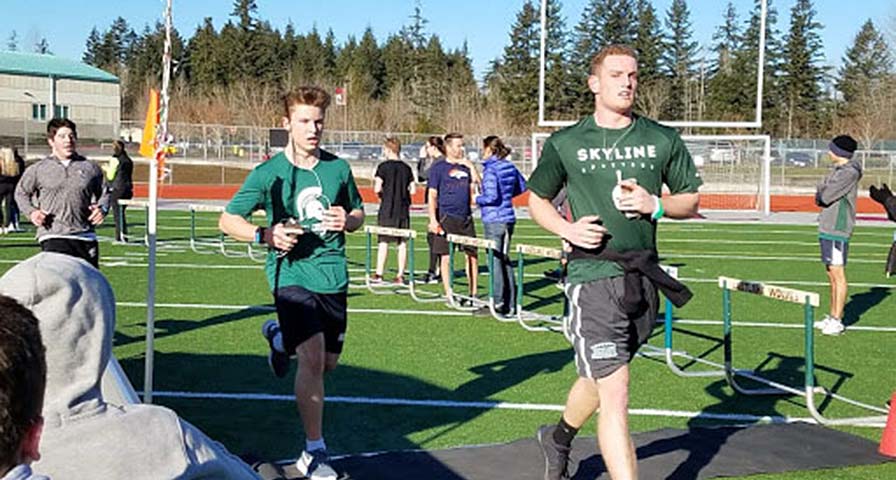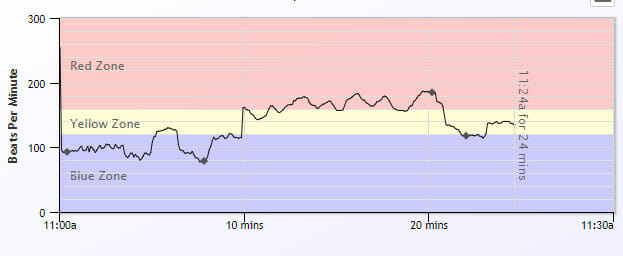Physical education students at Skyline High School (Issaquah School District 411, Washington) utilize heart rate monitors to concentrate on lowering their recovery heart rate.
Four times each semester, students in P.E. teacher Tracy Schellberg’s classes set off on a 12-minute run. Students check their heart rate immediately after the 12 minutes, then rest for two minutes before taking their heart rate again. It’s something she’s been studying for five years, getting the results she desires both for program validation and, more importantly, student health.
“Last semester, 80 percent of my students were able to drop their recovery heart rate to 120 beats per minute or less,” Schellberg said last month. “There was a steady improvement from the first assessment to the last.”
Developing Lifetime Fitness Skills
Resting and recovery heart rate serve as indicators of overall heart health. Generally, a lower resting heart rate indicates a higher fitness level. Exercise helps the heart become more efficient, delivering more blood through our systems in fewer beats per minute. For teenagers, healthy resting heart rates range from 70-100 beats per minute. For most healthy students, a maximum heart rate, factored either by a formula or a series of tests, ranges from 200-205 beats per minute.
Students exercising in their moderate-to-vigorous target heart rate zone strive to work out with a heart rate 70 percent of the maximum, or 140 beats per minute. With that goal in mind, Schellberg expects students to see a 20 beat per minute drop in heart rate in the first minute following exercise, a standard measure of a healthy recovery rate.
“We are looking to get the heart rate down to about 120 beats per minute,” she said.
By focusing on resting and recovery heart rate now, Schellberg enables students to begin developing skills that last their lifetimes.
Schellberg’s P.E. program at the 2,200-student high school focuses on an array of skills and games, but when it comes time to measure student fitness, she focuses on heart rate and running. In addition to the four 12-minute heart rate runs each semester, Skyline students also take part in a 5k with neighboring Eastlake High School. Students, even non-runners, set goals to complete the event and then work throughout the year to train for the big day. Between the two similarly-sized high schools, more than 1,200 students participate.
“They kind of get the big picture of why,” she said. “We’re not training to be cross country kids. But if you train for something and set goals, then that sense of accomplishment is something. You see these couch-to-5K programs where you take kids who’ve never run before and you train them up slowly, slowly working toward the 5K. For them to be able to run 3.1 miles is a pretty good feeling.”
Marking Recovery Heart Rate Progress
Schellberg’s students use the IHT Zone wrist heart rate monitors to measure their heart rate during class. During the 12-minute running tests, they use the monitor’s marker function to mark each time milestone. Students set the Zone’s marker three times:
- Starting the 12-minute run;
- Ending the 12-minute run;
- Ending the 2-minute recovery period
After class, they can check a detailed report that shows how their heart rate responded both during the run and in the crucial recovery period. Parents and administrators can see the data as well.
“When they look on their graph, they can see exactly where it is,” Schellberg said. “We’ve been able to send that home and show that to administrators and track that data. The parents like getting the emails that go home to the kids. It’s a good communication piece for everything. If you are doing this every day, the software tracks what the kid is doing and you can go back and look at it over time. It’s data. It’s great.”
From a teacher standpoint, having the data has helped simplify – and standardize – Schellberg’s grading process. With students wearing the heart rate monitors every day, everyone – teacher, student, parent and administrator – can see first-hand whether students met their goal of minutes spent exercising in the target heart rate zone. Students no longer receive grades based on perceived exertion – or simple participation.
“Rather than saying grades are based on effort, I can say grades are based on whether you’re getting your heart rate into the zone,” she said. “The kids know when their heart rate starts getting up, so if we’re in a game and there are kids who usually just stand around, you can see them start moving because they know that they have to be in the red for four minutes. You’ll see them sprint and try to get their heart rates up. It’s good to see them have a little self-motivation.”
While the short-term reward for that motivation comes in the form of a grade, the long-term reward comes as well.
“We want them to be able to determine what their fitness level is years from now,” she said. “You can always pick up a pencil a pair of running shoes. You don’t need a partner. You don’t need anything else. It’s a really quick way to stay in shape and being able to monitor your fitness level.”
Data-Driven Results
Skyline is the only school in Issaquah SD411’s 25-campus district with the heart rate monitors. Schellberg began teaching at Skyline in 2005 and changed her program to focus on heart rate in 2012. She used several different heart rate monitors before finding IHT’s chest monitors in 2015 and has since upgraded those – primarily through her departmental budget, to the Zone wrist monitors. Since she started collecting data, she’s seen consistent improvement in nearly every student throughout the school year.
“I’m tracking the data for one more semester and then I’ll take it to an admin and say, ‘see, look what we’ve done,’” she said. “We’ve been tracking data for 5 years. We can see their heart rate, recovery rate anyway, drop dramatically over what we’re doing in class.”
She’s hopeful that administrators will analyze the data she provides and expand the program throughout the district so more students can benefit from heart rate training.





